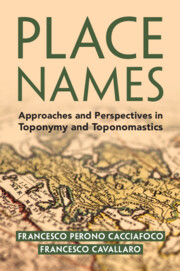Book contents
- Place Names
- Place Names
- Copyright page
- Contents
- Figures
- Tables
- Preface
- Acknowledgements
- 1 Introduction
- 2 Language Change
- 3 Historical Toponomastics
- 4 Toponymy and the Historical-Linguistic Reconstruction of Proto-Languages
- 5 Diachronic Toponymy
- 6 Landscape and Toponymy
- 7 Historical Toponomastics and Historical Geography
- 8 Synchronic Toponymy
- 9 Place Names and Society
- 10 Toponymy and Cartography
- Glossary
- References
- Index
10 - Toponymy and Cartography
Published online by Cambridge University Press: 02 March 2023
- Place Names
- Place Names
- Copyright page
- Contents
- Figures
- Tables
- Preface
- Acknowledgements
- 1 Introduction
- 2 Language Change
- 3 Historical Toponomastics
- 4 Toponymy and the Historical-Linguistic Reconstruction of Proto-Languages
- 5 Diachronic Toponymy
- 6 Landscape and Toponymy
- 7 Historical Toponomastics and Historical Geography
- 8 Synchronic Toponymy
- 9 Place Names and Society
- 10 Toponymy and Cartography
- Glossary
- References
- Index
Summary
This chapter introduces the readers to the relationship between toponymy and cartography. Although given for granted, place names are an essential component of a map. Toponyms serve important cartographic/topographic functions, such as helping users to search for and to locate places on a map. They also have an affective role; the act of seeing place names on a map evokes an emotional input that (re)connects a person with a place. Both toponyms and maps have the ideological function of possession and control of territories. This is especially true in colonial contexts. The chapter makes a note that maps are not a modern invention; they have been produced since ancient times and, hence, are useful in studying the denominations of old place names and the geopolitical realities of the past. In the final part of this chapter, the authors turn their attention to phantom place names, i.e., places that have been believed to be real and, although charted on maps, turned out to be non-existent. They are part of a broader set of legendary and literary place names that evoke what is called the ‘feeling of place’ and reveal much of the human nature (e.g., the love for exploration and the desire for beauty/earthly pleasures).
Keywords
- Type
- Chapter
- Information
- Place NamesApproaches and Perspectives in Toponymy and Toponomastics, pp. 242 - 265Publisher: Cambridge University PressPrint publication year: 2023



